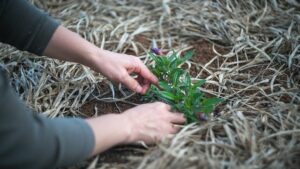When growing a lawn from seed, people often ask whether it’s best to fertilise before or after sowing the seeds. If you’re asking yourself this – planting or fertilising, what comes first? – we’ve got all the answers you need to clear this up once and for all.
Planting or fertilising – which first?
If you’re sowing a lawn from seed and you’re wondering whether you should fertilise before or after planting the seed, the short answer is that you should fertilise first. The long answer is that, either way is fine, as long as your seeds have access to all those delicious nutrients it shouldn’t really matter, but it’s best practice to fertilise first as it is more likely to deliver those nutrients most effectively.
To establish a strong and healthy lawn it’s important to give it the best start in life with soil that is properly prepared. As well as being adequately hydrated and aerated, it’s critical that your soil has the right balance of nutrients.
Whatever you do, seeding and fertilising should never be done at the same time. Doing so can cause uneven distribution of the seeds and the fertiliser, which leads to a patchy lawn. Some areas of soil can end up with no seeds, some areas no fertiliser, and some seeds may be burnt by excess fertiliser.
Fertilising before planting lawn seeds
For best results it is recommended to use a drop spreader, as they measure out the fertiliser more evenly than doing it by hand.
Measure out your fertiliser into two halves.
Spread the first half of the fertiliser by walking the drop spreader up and down the entire area in horizontal rows.
Spread the second half by walking up and down in vertical rows.
Overlap slightly on each row to ensure complete coverage.
Use a rake to work the fertiliser into the top 5 – 10 centimetres of the soil.
Which fertiliser should I use?
Not only can fertiliser be used to feed necessary nutrients to your seeds to help them grow, it can also adjust problems or deficiencies your soil may have. Working fertiliser through your soil before planting seeds can adjust the pH levels or replenish nitrogen. Sorting out these problems before you plant your new lawn is a far simpler and more effective approach than trying to do it afterward.
Organic matter, like compost or lawn clippings, is often recommended as a soil amending fertiliser. These things will not only improve nitrogen levels, but they’ll create a better texture and improve the soil’s ability to retain moisture and nutrients. If you’re going to work organic matter through your soil bed, however, it’s a good idea to make sure that it’s some pure compost or grass clippings. Wood and manure can introduce pathogens or be detrimental to nitrogen levels, so if you’re not sure if your organic matter contains these, it’s best to leave it out.
The ideal soil pH level for lawns is between 6.0 and 7.0. If you’re really serious about having an A grade lawn, check the soil pH before you plant. If your soil is too alkaline, opt for an ammonium fertiliser. This will not only deliver the usual useful nutrients to your seeds, it will fix the pH levels too. Problem solved!
If your soil is in tip top condition, or you just don’t have the time or compulsion to look too far into soil amending fertilisers, opting for a straight-up starter fertiliser is the way to go. These fertilisers have a higher phosphorus content than other varieties tailored to established plants. The phosphorus promotes healthy, strong root growth for your seedlings so that your lawn will be resilient and vibrant once established.
Once you’ve chosen your fertiliser and applied it properly, you can sow your new lawn seeds. With that healthy and nutritious base they’ll have the best start in life. When they start germinating, you won’t need to fertilise again for at least six weeks.



